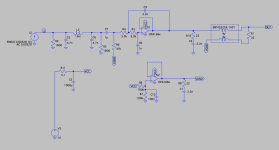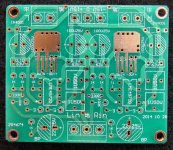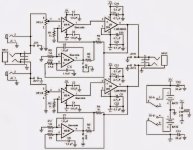I'm planning to build this minimal circuit. The source is an I-out DAC. One opamp creates a virtual ground–strong enough for 32ohm HPs to sit on, the other a DAC filter+driver for the headphones.
The main candidate has been the OPA1622 so far, for its large output current. Then I discovered the OPA1688, weaker but maybe enough for me and easy to solder. Also good with capacitive loads. Simulating both I found something puzzling...
Crucial here is that DC offset is extremely low I guess, since headphones are DC coupled. On paper the OPA1622 has 0.1mV VOS, the OPA1688 slightly more 0.25mV. But when I simulate both opamps in LTSpice, the 1622 shows quite surprisingly high(er) offset!
OPA1688: 0.22mV
OPA1622: 64mV
This is simply comparing the voltage difference between the opamp's output and VGND.
Are there any probably explanations to this? I read somewhere @johnc124 explaining that the OPA1622 model is quite detailed, not a 'macromodel'. So maybe there is a problem with the OPA1688 model not being accurate enough? Or this particular application creates troubles with the OPA1622 for having bipolar inputs, compared to the CMOS inputs of the 1688?
Just trying to double check which opamp is more suitable for this application and all comments are very much welcome!
The main candidate has been the OPA1622 so far, for its large output current. Then I discovered the OPA1688, weaker but maybe enough for me and easy to solder. Also good with capacitive loads. Simulating both I found something puzzling...
Crucial here is that DC offset is extremely low I guess, since headphones are DC coupled. On paper the OPA1622 has 0.1mV VOS, the OPA1688 slightly more 0.25mV. But when I simulate both opamps in LTSpice, the 1622 shows quite surprisingly high(er) offset!
OPA1688: 0.22mV
OPA1622: 64mV
This is simply comparing the voltage difference between the opamp's output and VGND.
Are there any probably explanations to this? I read somewhere @johnc124 explaining that the OPA1622 model is quite detailed, not a 'macromodel'. So maybe there is a problem with the OPA1688 model not being accurate enough? Or this particular application creates troubles with the OPA1622 for having bipolar inputs, compared to the CMOS inputs of the 1688?
Just trying to double check which opamp is more suitable for this application and all comments are very much welcome!
Attachments
Last edited:
Thank you @soekris that was a lead! I see now that the input bias current of the OPA1622 is quite high (1.2uA) and so is my input impedance (53.6k).
Both multiplied give exactly 64mV, so that must explain it 🙂
To compensate that and stay near unity gain I'd need a ˜51K resistor at the feedback loop and a 1meg from IN- to VGND, greatly increasing noise. So I guess another opamp is needed for this concept. The only I've found is the OPA1688. There is the CMOS TI (1656) with quite a stronger output (100mA), but not sure it won't oscillate without an output resistor.
I need a minimalist 1opamp per channel solution @Woka, sallen-key included.
Both multiplied give exactly 64mV, so that must explain it 🙂
To compensate that and stay near unity gain I'd need a ˜51K resistor at the feedback loop and a 1meg from IN- to VGND, greatly increasing noise. So I guess another opamp is needed for this concept. The only I've found is the OPA1688. There is the CMOS TI (1656) with quite a stronger output (100mA), but not sure it won't oscillate without an output resistor.
Yes @Nico Ras, I need this to be very immune to EMI therefore the output inductors.It seems very complex for a headphone amplifier. Is there extremely high RFI/EMI where you live?
I need a minimalist 1opamp per channel solution @Woka, sallen-key included.


